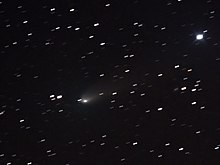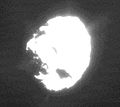81P/Wild
Semi-major axis 3.45 AU | | |
| Eccentricity | 0.5384 | |
|---|---|---|
| Orbital period | 6.408 a | |
| Inclination | 3.2394° | |
| Last perihelion | December 15, 2022[1] July 20, 2016[2] February 22, 2010[3] | |
| Next perihelion | May 14, 2029[4] | |
| Jupiter MOID | 0.012 AU (1,800,000 km)[5] | |
Comet 81P/Wild, also known as Wild 2 (pronounced "vilt two") (
For most of its 4.5 billion-year lifetime, Wild 2 probably had a more distant and
Nucleus parameters
- Dimensions: 5.5 km × 4.0 km × 3.3 km (3.4 mi × 2.5 mi × 2.1 mi)[8]
- Density: 0.6 g/cm3 (37 lb/cu ft)[9]
- Mass: 2.3 x 1013 kg (5.1 x 1013 lb)[10]
Exploration


Stardust · 81P/Wild · Earth · 5535 Annefrank · Tempel 1
NASA's
Stardust's "sample return canister" was reported to be in excellent condition when it landed in Utah, on January 15, 2006. A NASA team analyzed the particle capture cells and removed individual grains of comet and interstellar dust, then sent them to about 150 scientists around the globe.
As of 2006,
- "Both in the Solar System and in circumstellar disks crystalline silicates are found at large distances from the star. The origin of these silicates is a matter of debate. Although in the hot inner-disk regions crystalline silicates can be produced by means of gas-phase condensation or thermal annealing, the typical grain temperatures in the outer-disk (2–20 au) regions are far below the glass temperature of silicates of approx 1,000 K. The crystals in these regions may have been transported outward through the disk or in an outward-flowing wind.[15] An alternative source of crystalline silicates in the outer disk regions is in situ annealing, for example by shocks or lightning. A third way to produce crystalline silicates is the collisional destruction of large parent bodies in which secondary processing has taken place. We can use the mineralogy of the dust to derive information about the nature of the primary and/or secondary processes the small-grain population has undergone."
Results from a study reported in the September 19, 2008 issue of the journal Science has revealed an oxygen isotope signature in the dust that suggests an unexpected mingling of rocky material between the center and edges of the Solar System. Despite the comet's birth in the icy reaches of outer space beyond Pluto, tiny crystals collected from its halo appear to have been forged in the hotter interior, much closer to the Sun.[16]
In April 2011, scientists from the University of Arizona discovered evidence of the presence of liquid water. They found iron and copper sulfide minerals that must have formed in the presence of water. The discovery is in conflict with the existing paradigm that comets never get warm enough to melt their icy bulk. Either collisions or radiogenic heating might have provided the necessary energy source.[17]
On August 14, 2014, scientists announced the collection of possible
Gallery
| The Inward Migration of 81P | |||||||
| Year (epoch) |
Semi-major (AU)axis |
Perihelion (AU) |
Aphelion (AU) | ||||
|---|---|---|---|---|---|---|---|
| 1965 | 13 | 4.95[7] | 21[a] | ||||
| 1978[1] | 3.36 | 1.49 | 5.24 | ||||
-
Photograph taken by Stardust spacecraft
-
Details of the plume jets
-
Red/green stereo anaglyph
-
Stardust approach image
See also
Wild 2 has a similar name to other objects:
Notes
References
- ^ a b c "81P/Wild Orbit". Minor Planet Center. Retrieved February 26, 2017.
- ^ Nakano, Syuichi (December 12, 2009). "81P/Wild 2 (NK 1861)". OAA Computing and Minor Planet Sections. Retrieved February 24, 2010.
- ^ Kinoshita, Kazuo (April 13, 2005). "81P past, present and future orbital elements". Comet Orbit. FC2.
- ^ "Horizons Batch for 81P/Wild 2 (90000856) on 2029-May-14" (Perihelion occurs when rdot flips from negative to positive). JPL Horizons. Retrieved July 6, 2023. (JPL#K222/19 Soln.date: 22023-Jul-06)
- ^ "JPL Small-Body Database Browser: 81P/Wild 2" (last observation: 2016-06-26). Jet Propulsion Laboratory. Archived from the original on February 26, 2017.
- Bibcode:1978IAUC.3166....1W.
- ^ a b c Kronk, Gary W. (2001–2005). "81P/Wild 2". Cometography.com. Archived from the original on July 5, 2008. Retrieved October 23, 2008. (Cometography Home Page)
- ^ "Comet 81P/Wild 2". The Planetary Society. Archived from the original on January 6, 2009. Retrieved December 16, 2008.
- ^ Britt, D. T.; Consol-magno SJ, G. J.; Merline, W. J. (2006). "Small Body Density and Porosity: New Data, New Insights" (PDF). Lunar and Planetary Science XXXVII. Archived from the original (PDF) on December 17, 2008. Retrieved December 16, 2008.
- ^ Using the volume of an ellipsoid of 5.5×4.0×3.3 km * a rubble pile density of 0.6 g/cm3 yields a mass (m=d*v) of 2.28×1013 kg
- ^ Jeffs, William (January 18, 2006). "Scientists Confirm Comet Samples, Briefing Set Thursday". NASA. Archived from the original on March 9, 2008. Retrieved March 5, 2008.
- ^ McKeegan, K. D.; et al. "Light element isotopic compositions of cometary matter returned by the STARDUST mission" (PDF). Lawrence Livermore National Laboratory. Archived from the original (PDF) on January 26, 2017. Retrieved March 5, 2008.
- ^ Stricherz, Vince (March 13, 2006). "Comet from coldest spot in solar system has material from hottest places". University of Washington. Archived from the original on October 16, 2007. Retrieved March 5, 2008.
- S2CID 4362887.
- .
- ^ University of Wisconsin-Madison (September 15, 2008). "Comet Dust Reveals Unexpected Mixing of Solar System". Newswise. Retrieved September 18, 2008.
- ^ LeBlanc, Cecile (April 7, 2011). "Evidence for liquid water on the surface of Comet Wild-2". Archived from the original on May 12, 2011. Retrieved April 7, 2011.
- ^ Agle, DC; Brown, Dwayne; Jeffs, William (August 14, 2014). "Stardust Discovers Potential Interstellar Space Particles". NASA. Retrieved August 14, 2014.
- AP News. Archived from the originalon August 19, 2014. Retrieved August 14, 2014.
- ^ Hand, Eric (August 14, 2014). "Seven grains of interstellar dust reveal their secrets". Science. Retrieved August 14, 2014.
- S2CID 206556225.
- ^ Horizons output. "Comet 81P/Wild 2 [1978] (SAO/1978)". Retrieved February 26, 2017. (Observer Location:@Sun)
External links
- NASA/JPL homepage for Stardust project
- Stardust@Home Volunteer Particle Analysis Project
- 81P/Wild orbit and observations at IAU Minor Planet Center







